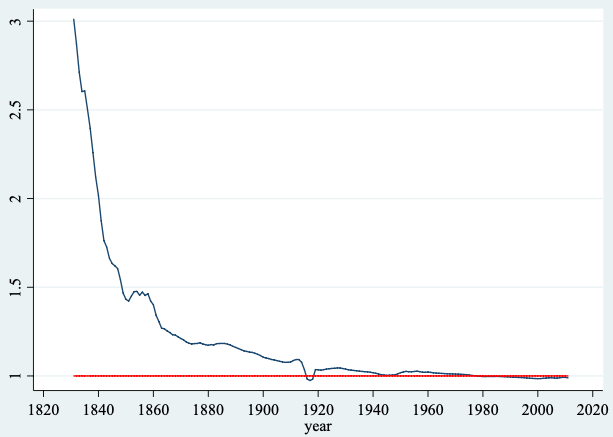What makes a ‘real’ man? According to traditional gender norms, men ought to be self-reliant, assertive, competitive, violent when needed, and in control of their emotions (Mahalik et al. 2003). Two current debates illustrate the profound economic and social impact of such masculinity norms. First, in many countries, men die younger than women and are consistently less healthy, with a penchant for violence and risk taking acting as important cultural drivers of the gender health gap (WHO 2013). A second debate links masculinity norms to occupational gender segregation. Technological progress and globalisation have disproportionately affected male employment, but many newly unemployed men refuse to fill jobs that do not match their self-perceived gender identity (Akerlof and Kranton 2000).
The extent to which men are expected to conform to stereotypical masculinity norms differs across societies, which raises the question: where do these norms come from? The origins of gender norms about women have been the focus of a vibrant literature (Giuliano 2018). By contrast, the origins of norms that guide and constrain the behaviour of men have received less attention in economics literature.
In recent research, we argue that strict masculinity norms can emerge in response to highly skewed sex ratios (the number of males relative to females) which intensify competition among men (Baranov et al. 2020). When sex ratios skew sharply male, competition for scarce females is more intense. This competition can intensify violence, bullying, and bravado – intimidating behaviours that, once entrenched in local culture, continue to manifest themselves long after sex ratios have normalised. We test this hypothesis using data from a unique natural experiment: the convict colonisation of Australia.
Australia as a historical experiment
To establish a causal link between sex ratios and the manifestation of masculinity norms, we exploit the convict colonisation of Australia. Between 1787 and 1868, Britain transported 132,308 convicted men and only 24,960 convicted women to Australia. Convicts were not confined to prisons, but allocated across colonies in a highly centralised manner. This created a variegated spatial pattern in sex ratios, and consequently in local male-to-male competition, in an otherwise homogeneous setting.
Convicts and ex-convicts represented the majority of the colonial population in Australia well into the mid-19th century. Voluntary migration was limited and comprised mainly of men migrating in response to male-biased economic opportunities available in agriculture and, after the discovery of gold in the 1850s, mining. Because of the predominance of male convicts and migrants, biased sex ratios endured for over a century (Figure 1).
Figure 1 Sex ratios in Australia: Number of men to every woman, 1830-2011
Source: Australian Bureau of Statistics
Identifying the lasting impact of skewed sex ratios
We regress present-day manifestations of masculinity norms, including violent behaviour, bullying, and stereotypically male occupational choices on historical sex ratios, collected from the first reliable census in each Australian state (see also Grosjean and Khattar 2019). Variation in historical sex ratios could reflect unobservable characteristics, an empirical challenge we tackle by instrumenting the historical sex ratio by the sex ratio among convicts only. This instrument is highly relevant, since most of the white Australian population initially consisted of convicts. Moreover, convicts were not free to move: a centralised assignment scheme determined their location as a function of labour needs, which we control for by initial economic specialisation. Throughout the analysis, we also control for time-invariant geographic and historic characteristics as well as key present-day controls (sex ratio, population, and urbanisation).
Masculinity norms among Australian men today
Using the above empirical strategy, we derive four sets of results:
1. Violence, suicide, and health
First we assess the impact of historically skewed sex ratios on present-day violence and health outcomes. Evidence suggests that men adhering to traditional masculinity norms attach a stronger stigma to mental health problems and tend to avoid health services. As a proxy for the avoidance of preventative health care, we use local suicide and prostate cancer rates. Prostate cancer is often curable if treated early, but avoidance of diagnosis is a public health concern. The endorsement of strict masculinity norms is also associated with aggression, excessive drinking, and smoking.
Our estimates show that rates of assault and sexual assault are higher today in parts of Australia that were more male biased in the past. A one unit increase in the historical sex ratio (defined as the ratio of the number of men over the number of women) is associated with an 11% increase in the rate of assault and a 16% increase in sexual assaults. We also find strong evidence of elevated rates of male suicide, prostate cancer, and lung disease in these areas. For male suicide – the leading cause of death for Australian men under 45 – a one unit increase in the historical sex ratio is associated with a staggering 26% increase.
2. Occupational gender segregation
A second manifestation of male identity is occupational choice. Our results paint a striking picture. A one unit increase in the sex ratio is associated with a nearly one percentage point shift from the share of men employed in neutral (e.g. real estate, retail) or stereotypically female occupations (e.g. teachers, receptionists) to stereotypically male occupations (e.g. carpenters, metal workers).
3. Support for same-sex marriage
We capture the political expression of masculine identity by opposition to same-sex marriage, which we measure using voting records from the 2017 nation-wide referendum on same-sex marriage. Our results show that the share of votes in favour of marriage equality is substantially lower in areas where sex ratios once showed more male bias. A one unit increase in the historical sex ratio is associated with a nearly three percentage point decrease in support for same-sex marriage. This is slightly over 6% of the mean.
4. Bullying
Lastly, we find that boys but not girls are more likely to be bullied at school in areas that used to be more male biased. The magnitude of the results is considerable and in line with the magnitude of the results for assaults (measured in adults). A one unit increase in the historical sex ratio is associated with a higher likelihood of parents (teachers) reporting bullying of boys by 13.7 (5.2) percentage points. This suggests that masculinity norms are perpetuated through horizontal transmission: peer pressure, starting at a young age on the playground.
Conclusions
We find that historically male-biased sex ratios forged a culture of male violence, help avoidance, and self-harm that persists in present-day Australia. While our experimental setting is unique, we believe our findings can inform debates about the long-term socioeconomic consequences and risks of skewed sex ratios in developing countries such as China, India, and parts of the Middle East. In these settings, sex-selective abortion and mortality along with the cultural relegation and seclusion of women have created societies with highly skewed sex ratios. Our results suggest that the masculinity norms that develop as a result may not only be detrimental to (future generations of) men themselves, but can also have important repercussions for other groups in society, particularly for women and sexual minorities.
Our findings also align with an extensive psychological and medical literature that connects traditional masculinity norms with an unwillingness among men to seek timely medical help or to engage in preventive health care and protective health measures (e.g. Himmelstein and Sanchez 2016, Salgado et al. 2016). This suggests that voluntary observance of health measures, such as social distancing during the COVID-19 pandemic, may be considerably lower among men who adhere to traditional masculinity norms.
References
Akerlof, G A and R E Kranton (2000), “Economics and Identity”, Quarterly Journal of Economics 115(3): 715–753.
Baranov, V, R De Haas and P Grosjean (2020), “Men. Roots and Consequences of Masculinity Norms”, CEPR Discussion Paper No. 14493, London.
Giuliano, P (2018), “Gender: A Historical Perspective”, The Oxford Handbook of Women and the Economy, Oxford University Press: New York.
Grosjean, P and R Khattar (2019), “It’s Raining Men! Hallelujah? The Long-Run Consequences of Male-Biased Sex Ratios”, The Review of Economic Studies, 86(2): 723–754.
Himmelstein, M S and D T Sanchez (2016), “Masculinity Impediments: Internalized Masculinity Contributes to Healthcare Avoidance in Men and Women”, Journal of Health Psychology 21: 1283–1292.
Mahalik, J R, B D Locke, L H Ludlow, M A Diemer, R P J Scott, M Gottfried and G Freitas (2003), “Development of the Conformity to Masculine Norms Inventory”, Psychology of Men & Masculinity 4(1): 3–25.
Salgado, D M, A L Knowlton and B L Johnson (2019), “Men’s Health-Risk and Protective Behaviors: The Effects of Masculinity and Masculine Norms”, Psychology of Men & Masculinities 20(2): 266–275.
WHO (2013), “Review of Social Determinants and the Health Divide in the WHO European Region”, World Health Organization, Regional Office for Europe, Copenhagen.






